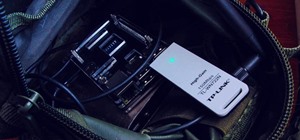I Inadvertently Left Kali Running a Scan on Local APs Using the Airodump Function in Aircrack Whilst I Was Away for a Couple of Days. Upon My Return I Find That It Has Seemingly Grabbed Shedloads of WPA Handshakes for Various BSSIDs Whilst I've Been Away. As I'm Used to Using the Tutorials on Here (Whereby You Use the -W Command to Create a File for the Captured 'Shakes) I've No Idea Where to Find the Handshakes. I Know I Need to Make a Start on the Linux Basics Tutorials but Any Assistance in the Interim on Locating and Getting to Grips on the 'Shakes I've Grabbed Would Be Appreciated.
Forum Thread: Confused Noob
- Hot
- Active
-
 Forum Thread:
Gaining Access into the Victim's Whatsapp on Android
12
Replies
Forum Thread:
Gaining Access into the Victim's Whatsapp on Android
12
Replies
4 hrs ago -
 Forum Thread:
Whatsapp Hack?
19
Replies
Forum Thread:
Whatsapp Hack?
19
Replies
6 hrs ago -
 Forum Thread:
HACK ANDROID with KALI USING PORT FORWARDING(portmap.io)
12
Replies
Forum Thread:
HACK ANDROID with KALI USING PORT FORWARDING(portmap.io)
12
Replies
3 days ago -
 Forum Thread:
Hydra Syntax Issue Stops After 16 Attempts
2
Replies
Forum Thread:
Hydra Syntax Issue Stops After 16 Attempts
2
Replies
3 wks ago -
 Forum Thread:
Hack Instagram Account Using BruteForce
208
Replies
Forum Thread:
Hack Instagram Account Using BruteForce
208
Replies
3 wks ago -
 Forum Thread:
Metasploit reverse_tcp Handler Problem
47
Replies
Forum Thread:
Metasploit reverse_tcp Handler Problem
47
Replies
2 mo ago -
 Forum Thread:
How to Train to Be an IT Security Professional (Ethical Hacker)
22
Replies
Forum Thread:
How to Train to Be an IT Security Professional (Ethical Hacker)
22
Replies
2 mo ago -
 Metasploit Error:
Handler Failed to Bind
41
Replies
Metasploit Error:
Handler Failed to Bind
41
Replies
2 mo ago -
 Forum Thread:
How to Hack Android Phone Using Same Wifi
21
Replies
Forum Thread:
How to Hack Android Phone Using Same Wifi
21
Replies
3 mo ago -
 How to:
HACK Android Device with TermuX on Android | Part #1 - Over the Internet [Ultimate Guide]
177
Replies
How to:
HACK Android Device with TermuX on Android | Part #1 - Over the Internet [Ultimate Guide]
177
Replies
3 mo ago -
 How to:
Crack Instagram Passwords Using Instainsane
36
Replies
How to:
Crack Instagram Passwords Using Instainsane
36
Replies
3 mo ago -
 Forum Thread:
How to Hack an Android Device Remotely, to Gain Acces to Gmail, Facebook, Twitter and More
5
Replies
Forum Thread:
How to Hack an Android Device Remotely, to Gain Acces to Gmail, Facebook, Twitter and More
5
Replies
3 mo ago -
 Forum Thread:
How Many Hackers Have Played Watch_Dogs Game Before?
13
Replies
Forum Thread:
How Many Hackers Have Played Watch_Dogs Game Before?
13
Replies
3 mo ago -
 Forum Thread:
How to Hack an Android Device with Only a Ip Adress
55
Replies
Forum Thread:
How to Hack an Android Device with Only a Ip Adress
55
Replies
4 mo ago -
 How to:
Sign the APK File with Embedded Payload (The Ultimate Guide)
10
Replies
How to:
Sign the APK File with Embedded Payload (The Ultimate Guide)
10
Replies
4 mo ago -
 Forum Thread:
How to Run and Install Kali Linux on a Chromebook
18
Replies
Forum Thread:
How to Run and Install Kali Linux on a Chromebook
18
Replies
5 mo ago -
 Forum Thread:
How to Find Admin Panel Page of a Website?
13
Replies
Forum Thread:
How to Find Admin Panel Page of a Website?
13
Replies
6 mo ago -
 Forum Thread:
can i run kali lenux in windows 10 without reboting my computer
4
Replies
Forum Thread:
can i run kali lenux in windows 10 without reboting my computer
4
Replies
6 mo ago -
 Forum Thread:
How to Hack School Website
11
Replies
Forum Thread:
How to Hack School Website
11
Replies
6 mo ago -
 Forum Thread:
Make a Phishing Page for Harvesting Credentials Yourself
8
Replies
Forum Thread:
Make a Phishing Page for Harvesting Credentials Yourself
8
Replies
6 mo ago
-
 How To:
Crack SSH Private Key Passwords with John the Ripper
How To:
Crack SSH Private Key Passwords with John the Ripper
-
 How To:
Use Burp & FoxyProxy to Easily Switch Between Proxy Settings
How To:
Use Burp & FoxyProxy to Easily Switch Between Proxy Settings
-
 How To:
Scan for Vulnerabilities on Any Website Using Nikto
How To:
Scan for Vulnerabilities on Any Website Using Nikto
-
 How To:
Check if Your Wireless Network Adapter Supports Monitor Mode & Packet Injection
How To:
Check if Your Wireless Network Adapter Supports Monitor Mode & Packet Injection
-
 How To:
Crack Password-Protected Microsoft Office Files, Including Word Docs & Excel Spreadsheets
How To:
Crack Password-Protected Microsoft Office Files, Including Word Docs & Excel Spreadsheets
-
 How To:
Crack Shadow Hashes After Getting Root on a Linux System
How To:
Crack Shadow Hashes After Getting Root on a Linux System
-
 How To:
Use SQL Injection to Run OS Commands & Get a Shell
How To:
Use SQL Injection to Run OS Commands & Get a Shell
-
 How To:
Spy on Traffic from a Smartphone with Wireshark
How To:
Spy on Traffic from a Smartphone with Wireshark
-
 Hacking Windows 10:
How to Dump NTLM Hashes & Crack Windows Passwords
Hacking Windows 10:
How to Dump NTLM Hashes & Crack Windows Passwords
-
 How To:
Dox Anyone
How To:
Dox Anyone
-
 How To:
Create Custom Wordlists for Password Cracking Using the Mentalist
How To:
Create Custom Wordlists for Password Cracking Using the Mentalist
-
 How To:
Fuzz Parameters, Directories & More with Ffuf
How To:
Fuzz Parameters, Directories & More with Ffuf
-
 How To:
The Essential Skills to Becoming a Master Hacker
How To:
The Essential Skills to Becoming a Master Hacker
-
 How To:
Steal Ubuntu & MacOS Sudo Passwords Without Any Cracking
How To:
Steal Ubuntu & MacOS Sudo Passwords Without Any Cracking
-
 How To:
Map Wardriving Data with Jupyter Notebook
How To:
Map Wardriving Data with Jupyter Notebook
-
 How To:
Use Metasploit's Web Delivery Script & Command Injection to Pop a Shell
How To:
Use Metasploit's Web Delivery Script & Command Injection to Pop a Shell
-
 How To:
Turn Any Phone into a Hacking Super Weapon with the Sonic
How To:
Turn Any Phone into a Hacking Super Weapon with the Sonic
-
 How To:
The Null Byte Guide to 3D Printing for Hackers
How To:
The Null Byte Guide to 3D Printing for Hackers
-
 How To:
Gain SSH Access to Servers by Brute-Forcing Credentials
How To:
Gain SSH Access to Servers by Brute-Forcing Credentials
-
 How To:
Enumerate SMB with Enum4linux & Smbclient
How To:
Enumerate SMB with Enum4linux & Smbclient

















2 Responses
Ciuffy is correct about the headline - I don't post much and was rushing off to a beer festival. Many thanks for your help.
A few things you can do (assuming you're using Kali):
Open up a terminal and run from the command line:
wpaclean new.cap old.cap
Note that the order in this is the opposite of what you'll usually see -- enter the file name you want to give your clean cap file FIRST, and then the file of the one you have now. e.g.
wpaclean SmallCap.cap HugeCapBecauseILeftAirCrackRunning.cap
This will strip the file down to only the relevant handshakes (you only need two from each set, but they have to be the right two).
pyrit -r Old.cap -o New.cap strip
This will strip it down to just handshakes, but won't pre-select them for you.
After that you can run:
pyrit -r New.cap analyze
This will return a list of all handshakes, and tell you if they're usable ("good spread") or not.
And, finally, you can do it manually by opening the cap file in wireshark and selecting individual packets. See this for an explanation:
http://aircrack-ng.org/doku.php?id=wpa_capture&DokuWiki=074d5917c87bb3032d8c42de85f2e8da
Caveat:
I've only ever used these on cap files that captured handshakes from a single ESSID. Not certain how they'll work if you have dozens of different ESSIDs in there.
What I've done is run pyrit strip on the cap file first, run pyrit analyze on it, and then run it through wpaclean. Then I'll open up the final cap file in wireshark and make sure they all look good. But I think you can get away with just wpaclean.
Share Your Thoughts